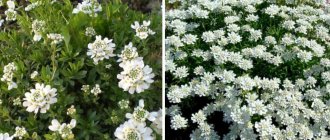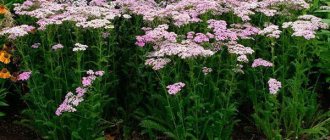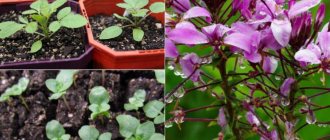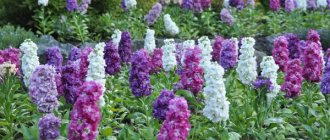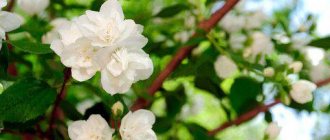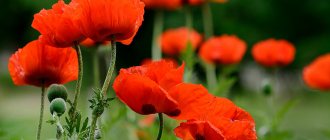September flowers - this is how gardeners affectionately call Aster virginiana or Novi-Belgii (the scientific name for September flowers is Symphyotrichum novi-belgii), since the flowering period begins in September. Inflorescences of snow-white, blue, lilac, cornflower blue, pink, and purple shades flaunt until late autumn.
So unpretentious that they grow like weeds
This representative of the Asteraceae family is native to North America. September flowers have taken root well in our area, quickly run wild and can grow without any care for decades. Lush flowering bushes can be found on the approaches to the taiga zone.
Septembers in the wild photo
The shape of the bush looks like an inverted pyramid. The stems are powerful, erect, well branched, densely covered with small leaves.
Huge variety of varieties
Perennial September asters have many faces: there are huge bushes about 2 m high and compact clumps barely reaching a height of 30 cm. At the end of August they are covered with numerous buds, and by mid-September the riotous flowering will take your breath away.
All the beauty lies in the huge number of corollas with a diameter of about 1-5 cm, collected in basket inflorescences. The leaves fall off, and the flowers can withstand temperatures as low as -50 °C. If warm weather returns, they will continue their beauty parade.
This unpretentious perennial will be a wonderful decoration for any corner of the garden.
Bloom
About 200 inflorescences open simultaneously on one bush. The corollas look like daisies: the core (yellow-orange, less often red or burgundy) is framed by a large number of narrow petals. The most common colors are lilac and purple.
Growing September flowers from seeds
September seeds from seeds, photo of seedlings
Seed propagation of September flowers involves growing seedlings. It is unlikely that you will be able to collect the seeds yourself - they do not have time to ripen, and if they reach the desired state, they quickly lose their germination capacity. Go to a flower shop for seed material.
- Start sowing September seeds in February.
- You will need wide containers or seedling boxes with a universal substrate.
- Plant the seeds to a depth of no more than 0.5 cm: it is enough to spread them over the surface of the soil, only lightly pressing them into the soil.
- Spray with a fine spray, cover with film or glass on top, maintain the air temperature in the range of 22-25 °C, and provide diffused lighting.
After 3-4 weeks, sprouts will appear, then the cover can be removed. During this time, do not forget to regularly ventilate the crops and maintain soil moisture by spraying. Water the seedlings moderately. If the sprouts are stretching, provide additional lighting. At the stage when two true leaves appear, plant them in separate containers.
After about 10 days of growth, feed with complex mineral fertilizers. From mid-April, start hardening the seedlings: take them out into the open air every day for 30-40 minutes. Transplant into open ground in May.
Organization of wintering
Before wintering, the stem must be cut to the ground, fallen leaves must be collected with a rake and burned along with the cut stem.
Now wood ash is poured into the soil in the following proportion: 100 grams of ash per 1 square meter. This will saturate the soil with potassium and reduce its acidity.
Young shoots can be covered with peat and sprinkled with spruce branches or leaves until the first frosts appear. Adult September flies do not need additional shelter.
Vegetative propagation of September flowers
Dividing the bush is the most popular method of propagating September flowers. The procedure can be carried out in spring or autumn. Every 2-3 years, the bush is completely dug up, divided into parts (the division should contain part of the rhizome with 1-2 growth buds) and planted. The plant produces basal shoots - they can be planted annually. Carefully dig up from the edge of the mother bush and cut off the young plant with a sharp shovel.
After pruning, the side shoots can be used as cuttings. Root in water, roots will appear in about 20 days - you can plant them in open ground.
Planting and caring for September flowers in open ground
September in the garden photo
Site preparation
Site preparation must be done in advance. A couple of weeks before planting, dig to the depth of a spade and add organic matter (humus) and a complex of mineral fertilizers. Immediately on the day of planting, make holes the size of the root system, water well and let it soak. Then place the seedlings, add the missing amount of soil, and carefully press the soil with your palms.
How to plant
Keep a distance of about half a meter between individual plants. When planting along a path, the distance can be reduced to 20 cm. Plant September flowers separately from other plants, since the rhizome is capable of taking all the moisture from the area.
How to water
The first 10-14 days after planting should be watered about every other day so that the plants take root successfully.
Plants will not cause much trouble in caring for them; it is necessary to carry out basic procedures: watering, loosening the soil, feeding them with fertilizers, and carrying out sanitary pruning.
September flowers tolerate temporary drought well, and waterlogging of the soil can cause significant harm (disease damage). In principle, the plant can do without watering, but flowering will be sparse. Water approximately once a week in dry, hot weather; at average levels of temperature and air humidity, the interval is increased to 16 days. It is better to use warm water for watering.
Feeding
It is enough to feed 2-3 times per season. Use complex mineral fertilizers. Fertilize for the first time in early spring, focusing on the proportion of nitrogen; carry out the second feeding in mid-summer, introducing more potassium; the third can be carried out during budding or during flowering with a predominance of the phosphorus component.
Mandatory measures to maintain the plant in a healthy condition are regular loosening of the soil and removal of weeds.
Trimming
Sanitary pruning is carried out throughout the entire growing season: remove dried leaves and inflorescences, and also trim damaged or out-of-shape shoots. In the autumn, when the September flowers have faded, the shoots are cut off at the root, leaving stumps about 2 cm high.
Trimming
The peculiarity of the New Belgian aster is that there is no need to form a bush. It is spherical in shape and blooms luxuriantly.
During the season, it is enough to carry out sanitary cleaning - trimming dried inflorescences and dry stems.
For wintering, the entire above-ground part is cut off at the root.
When to replant September trees?
When to plant September trees is an important question. Aster virginiana bushes that grow in one place for a long time need to be transplanted. Over time, the soil becomes compacted and depleted, which prevents normal access of oxygen to the roots. Bushes tend to grow - continuous dense plantings will interfere with each other. The situation will be changed by replanting, which is carried out approximately once every 4 years (combine with dividing the bush).
As for the timing, it is preferable to do this in the spring: the bushes will have time to take root well and get stronger before wintering. If you replant in the fall, do it as early as possible - the plants should at least take root.
In the video, autumn planting of September flowers:
Aster virginiana, or what flowers are called September flowers, description of the plant
Septembers are also called Virginia Aster. The homeland of this perennial plant is North America. The name comes from the fact that these plants bloom profusely from the first days of September until frost.
Characteristics and features:
- The bush is small in height, growth ranges from 40 to 110 centimeters, depending on the type and variety.
- The plant is perennial and frost-resistant, able to withstand temperatures down to -5 degrees.
- The bushes have a lush crown.
- Inflorescences of various shades: white, pink, blue, lilac and purple. In Russia, purple flowers are more common.
Used as border decorative flowers.
The appearance allows you to keep the flower bed in good condition until late autumn. The plant blooms profusely until the first snow falls. The main thing is to water, prune and care for the perennial on time, according to the requirements.
Even more information about September flowers and caring for them is in the video:
Diseases and pests
The plant has a fairly high resistance to diseases and pests.
Powdery mildew is a disease typical of all members of the Asteraceae family. If you do not react immediately, a strong and beautiful bush can wither at lightning speed. The disease is difficult to prevent: spores of the pathogenic fungus are transmitted by air, enter through water or hands, objects (gloves, garden shears) that have been in contact with diseased plants. The main symptom is the appearance of spots in the form of a whitish coating - it can be brushed off with your hand, like dust. After a while there are more and more of them. It is necessary to treat with a copper-based fungicidal preparation. For preventive purposes, treatment can be carried out with Bordeaux mixture or copper sulfate solution.
Other possible diseases: blackleg, fusarium, rust. Treat with a fungicide (foundazol, quick, previkur, etc.).
Pests: meadow bugs, spider mites, aphids, earwigs, cutworm butterflies. Apply insecticide treatment. Sometimes you can find slugs - they are collected by hand or using special traps.
September in landscape design
September in landscape design photo
September flowers give their beauty at the end of summer, not afraid even of the first cold snaps and the sudden fall of the first snow.
September in garden design photo
These unpretentious perennials are welcome guests in the garden. Bushes with delicate inflorescences look great in single and group plantings; they are used to frame garden paths, borders, and the base of bushes (on the south side).
September in landscape design photo
They look great in a mixborder with their family members. Neighbors can be hardy, drought-resistant plants, for example, chrysanthemums, rudbeckias, anemones.
Where is the best place to plant September
It is not difficult to find a place for these flowers - they look good in any corner of the garden. They are good both on their own and in mixed plantings. September flowers decorate the far corners of the garden very well - after the rest of the flowers have faded, September trees will delight you with their lilac petals for a long time.
If you want to make mixed flower beds, you should not plant low annuals such as petunias or pansies next to the September flowers - an active perennial will quickly crowd them out, taking up all the free space. It is preferable to plant the same drought-resistant and unpretentious flowers next to September - for example, medium-sized chrysanthemums.
But these plants still look best in single plantings, or as a border flower.
The best September varieties with photos and names
There are many varieties of Aster virginiana, let's look at some of them.
Dwarf varieties (about 40 cm high):
September variety Audrey Symphyotrichum novi-belgii Audrey photo of flowers
Audrey – lilac-pink color;
September Jenny Symphyotrichum novi-belgii Jenny photo
Jenny - miniature bushes with red inflorescences;
September Snowsprite Symphyotrichum novi-belgii Snowsprite photo
Snowsprite - a bush decorated with snow-white inflorescences.
Medium height varieties:
Elina - bushes about 80 cm high fascinate with lush flowering, corollas reach a diameter of 5 cm, the color is bright pink.
September Cassie
Cassie - the height of the bush is 85 cm. Snow-white corollas with a diameter of about 3 cm form a continuous covering.
September Aster novi-belgii 'Winston S. Churchill' photo
Winston S. Churchill - plant height is limited to 70 cm. Ruby-colored flowers.
September Royal Velvet Aster novi-belgii 'Royal Velvet'
Royal Velvet – the color is purple with a bluish tint, the bush seems to glow.
Tall varieties
Reach a height of 1 m or more, the diameter of the corolla is 3.5-4 cm:
September White Ladys Symphyotrichum novi-belgii White Ladys photo
White Lady - the height of the bush is 1.1 m. The inflorescences are snow-white with a yellow core.
September Lady in Blue Aster novi-belgii Lady in Blue photo
Desertblue – blue-lilac color scheme of inflorescences.
Dastyrose - flowers of a soft crimson hue.
Amethyst - semi-double inflorescences, dark purple petals.
September Dick Ballard Dick Ballard photo
Dick Ballard – soft pink petals arranged in 2 rows.
Description of the September flower
September flower is a perennial herbaceous plant. Flowering begins in September and ends with the onset of the first drop in air temperature and the appearance of snow. The September flower can come in a variety of colors, from pale pink to deep purple. Such an abundance of colors will truly make the garden the envy of others. The shape of the flowers resembles a miniature aster. September flowers grow in small bushes. The height of the plant stem reaches from 30 centimeters to 1 meter. This feature makes the September flower in demand among designers for the purpose of creating decorations and fencing the territory. In spring, the bushes become denser and form a green mass, which blooms with a bright and lush head by autumn. To acquire this plant, you can purchase ready-made September flowers of any color.
September flower or autumn perennial aster
